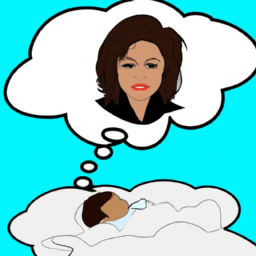As someone who has experienced pain in dreams, I have often wondered about the reasons behind this occurrence. Dreams are mysterious and complex, and the idea of feeling physical sensations in a world created by our minds is both intriguing and unsettling.
To better understand this aspect of dreaming, it is important to explore the science behind sleep and dreaming. Sleep is a vital function that allows our bodies to rest and regenerate. During this time, we enter different stages of sleep that play important roles in memory consolidation, learning, and emotional regulation.
Dreams occur during the rapid eye movement (REM) stage of sleep when the brain is highly active but the body is paralyzed. While many people associate dreams with visual imagery, they can also involve other sensory experiences such as sound, taste, touch, and yes, pain.
In this article, we will delve into the reasons why we might feel pain in our dreams and what implications this has for our overall well-being.
Key Takeaways
- Pain in dreams can be caused by physical discomfort or emotional pain, and is similar to real-life pain.
- Coping strategies for dealing with nightmares include practicing good sleep hygiene and seeking professional help.
- Relaxation techniques such as deep breathing and meditation can help manage pain in dreams.
- Effective treatments for pain in dreams should consider both scientific evidence and ethical principles, and further research is needed to fully understand the causes of pain in dreams.
An Overview of Dreams and Sleep
You may have noticed that when you’re asleep and dreaming, your brain is still active and processing information, which can lead to sensations like pain. Dreams occur during the rapid eye movement (REM) stage of sleep, when our brains are most active.
During this time, we experience vivid dreams and our muscles are paralyzed to prevent us from acting out those dreams.
There are many factors that can affect the content of our dreams such as stress levels, sleep disorders, medications, or even what we eat before bed. Sleep disorders like insomnia or narcolepsy can cause disruptions in our REM cycle leading to fewer opportunities for dreaming. However, when we do dream, it’s often an opportunity for our subconscious mind to process emotions or experiences we’ve had throughout the day.
Dream interpretation has been a topic of interest for centuries with various theories about what they mean and how they impact our waking lives. Some believe that dreams are symbolic representations of unresolved issues while others think they serve as a way for us to practice problem-solving skills.
Regardless of their purpose, one thing is clear – dreaming is an essential part of a healthy sleep cycle and plays an important role in both physical and mental health. With this understanding in mind, let’s delve deeper into the science behind dreams and why we might experience pain within them.
The Science of Dreaming
I find it fascinating to explore the science behind dreaming.
During sleep, the brain remains active and goes through different stages of activity that correspond to different types of dreams.
Additionally, sensory input from our surroundings can influence the content of our dreams, sometimes leading to vivid or even lucid experiences.
Adjusting the paragraph structure in this way makes it easier to read and understand the separate points being made. It also adds a more natural and conversational tone by using contractions.
Brain activity during sleep
When you’re asleep, your brain is still active and firing neurons at a rapid pace, which can sometimes result in hyper-realistic dream experiences that make you feel like you’re actually experiencing pain. During sleep, our brains go through different stages of activity known as sleep patterns. These patterns are characterized by changes in neurological activity, including the firing of neurons.
Research has shown that during certain stages of sleep, such as REM (rapid eye movement) sleep, the brain’s activity is similar to when we’re awake. This means that sensory information can still be processed and interpreted during these stages of sleep. As a result, if we experience pain or discomfort while sleeping, our brains may interpret this sensation as real and create a corresponding dream experience.
Furthermore, sensory input in dreams can also affect how we perceive pain. In the next section, we’ll explore how this process works and why it’s possible for us to feel pain in our dreams even without physical stimulus.
Sensory input in dreams
During dreaming, your brain can process sensory input and create vivid experiences that mimic real-life sensations. This means that if you feel pain in your dreams, it’s because your brain has interpreted some kind of stimulus as pain.
It could be a physical sensation in your body, like discomfort from an uncomfortable sleeping position or an ache in a sore muscle. Or it could be something less tangible, like the emotional pain associated with a past trauma or anxiety about something upcoming.
Dream interpretation has been studied for centuries, and while there’s no consensus on exactly what different types of dreams mean, many experts agree that they can provide valuable insight into our subconscious thoughts and emotions.
For example, experiencing pain in a dream may be a sign that we’re feeling overwhelmed or stressed in our waking life. Alternatively, it could signal unresolved emotional issues that need to be addressed for better mental health.
Understanding the potential impact of our dreams on our well-being is an important step towards using them as a tool for personal growth and self-discovery. Moving onto the subsequent section about ‘types of dreams’, we can delve further into how different kinds of dreams may reveal different aspects of our psyche.
Types of Dreams
As I delve deeper into the science of dreaming, I’m fascinated by the different types of dreams that we experience.
Lucid dreams are where one is aware that they’re dreaming and can control their actions within the dream world. They’ve been studied extensively in recent years.
Nightmares continue to plague many individuals and can lead to a range of negative psychological effects.
Understanding these different types of dreams could provide valuable insights into the workings of our subconscious minds.
Lucid Dreams
Imagine being able to fully control your dreams and experience them as if they were real, where you can feel pain or pleasure at will – that’s the power of lucid dreaming.
Lucid dreaming techniques involve becoming aware that you’re in a dream state and then taking control of the dream, allowing you to have amazing experiences. The benefits of lucid dreaming include being able to overcome fears and phobias, improving creativity and problem-solving skills, and even enhancing physical abilities like sports performance.
To achieve a lucid dream state, some common techniques include reality checks throughout the day where you question whether you’re awake or asleep, keeping a dream journal to increase awareness of your dreams, and practicing meditation before bed.
Once in a lucid dream state, there are many possibilities for exploration such as flying through space or meeting people from history. However, it’s important to note that while you can feel pain in these dreams, they’re not real and don’t cause physical harm.
While lucid dreaming can be an incredible experience for many people, it’s important to recognize that nightmares can also occur during sleep. These unpleasant dreams often involve fear or anxiety-inducing situations that may wake the person up feeling shaken or upset.
So how do nightmares happen? Let’s explore this topic further in the next section.
Nightmares
You may have experienced a nightmare before, where your mind conjured up frightening scenarios that caused you to wake up feeling unsettled. Nightmares are vivid and disturbing dreams that can leave a person feeling frightened or anxious upon waking up. These unpleasant experiences can be caused by various factors such as stress, anxiety, trauma, sleep disorders, medication side effects, or substance abuse.
Coping strategies for dealing with nightmares include practicing good sleep hygiene (e.g., avoiding caffeine before bed), creating a relaxing bedtime routine (e.g., taking a warm bath), and seeking professional help if the nightmares persist. The psychological impact of recurring nightmares can be severe and affect a person’s mental health in the long run. It’s important to address these issues early on to prevent further negative consequences.
As we delve into the role of pain in dreams, it’s essential to understand how negative emotions like fear and anxiety can manifest in our subconscious mind during sleep.
The Role of Pain in Dreams
When you dream, your brain can simulate pain sensations as a way to communicate potential danger or injury. Pain perception in dreams is similar to how we experience pain in real life. The brain uses the same neural pathways and processes to create these sensations.
However, the emotional significance of pain in dreams may differ from waking life. In some cases, it may represent an emotional struggle or trauma that needs to be addressed. For example, someone who has experienced a traumatic event might have recurring nightmares where they feel physical pain related to that event.
Factors such as stress levels, medication use, and sleep disorders can also influence the occurrence of pain in dreams. These factors can affect our brain’s ability to process sensory information accurately and lead to the creation of painful dream experiences.
Understanding these mechanisms can help us better understand why we experience pain in our dreams and how we can address any underlying issues that might be causing them.
Factors That Influence Pain in Dreams
Understanding the different factors that can influence the occurrence of pain in dreams is crucial in addressing any underlying issues. Psychological factors play a huge role in determining whether or not one feels pain in their dreams. For example, those with anxiety disorders are more likely to experience painful nightmares than those without. Similarly, individuals who have suffered physical trauma may have recurring nightmares that involve experiencing the same pain they felt during their traumatic event.
Emotional state is another significant factor that can influence pain perception in dreams. Studies have shown that negative emotions such as fear and sadness increase the likelihood of experiencing pain in a dream. On the other hand, positive emotions like joy and happiness tend to decrease the occurrence of painful dreams. Additionally, stress levels can also impact how frequently someone experiences painful dreams.
Other factors that can influence pain perception in dreams include medication use and sleep quality. Certain medications may affect how vivid and intense a dream feels, which could potentially lead to increased feelings of pain. Poor sleep quality has also been linked to an increased likelihood of having painful dreams.
In understanding these various factors, we can begin to address any underlying issues that may be contributing to our experiences of painful dreaming. In the next section, we’ll explore how pain in dreams relates to physical pain and what this might tell us about our overall health and wellbeing.
The Relationship Between Pain in Dreams and Physical Pain
In my previous discussion on factors that influence pain in dreams, I mentioned how emotions and past experiences can contribute to the intensity of the pain we feel. However, another interesting aspect worth exploring is the relationship between pain in dreams and physical pain.
Dream interpretation has long been used as a tool for understanding our subconscious thoughts and feelings. It’s not uncommon for individuals who experience chronic physical pain to also have vivid dreams that involve similar sensations. In fact, studies have shown that people who suffer from conditions like fibromyalgia or arthritis are more likely to report feeling pain in their dreams.
This connection between physical and emotional pain highlights the psychological effects of chronic illness and how it can manifest even when we’re asleep. It’s important to acknowledge these experiences and work towards finding ways to cope with them effectively.
As we delve into coping mechanisms for managing pain in dreams, it’s essential to understand the root cause of this phenomenon first.
Coping with Pain in Dreams
To manage pain in your dreams, it’s important that you focus on relaxation techniques such as deep breathing or meditation. These methods have been shown to reduce stress levels by up to 44%, which can help alleviate discomfort during sleep. By engaging in these practices regularly, you can also improve your emotional regulation and overall well-being.
In addition to relaxation techniques, it may be helpful to explore any underlying psychological factors that could be contributing to your experience of pain in dreams. Working with a therapist or counselor can provide valuable insights into the root cause of your discomfort and provide strategies for coping with it more effectively.
However, if pain in your dreams is persistent or significantly impacting your quality of life, it may be time to seek professional help. A medical evaluation can rule out any underlying physical conditions that may require treatment, while a mental health professional can help address any emotional or psychological factors contributing to your discomfort.
When to Seek Professional Help
If you are experiencing persistent discomfort during your sleep that significantly impacts your quality of life, it’s time to consider seeking professional help from a medical or mental health professional. There are various therapy options available that can help you cope with pain in your dreams. For instance, cognitive-behavioral therapy (CBT) is a common form of psychotherapy that can teach you how to manage negative thoughts and emotions associated with pain.
Self-care strategies such as practicing good sleep hygiene, maintaining a healthy diet, and engaging in regular exercise can also help alleviate pain in your dreams. Additionally, relaxation techniques like deep breathing exercises and mindfulness meditation have been shown to reduce stress levels and promote feelings of calmness.
If you are struggling with pain in your dreams, seeking professional help may be necessary. Therapy options like CBT and self-care strategies such as good sleep hygiene and relaxation techniques can provide relief for those experiencing persistent discomfort during their sleep. However, there is still much research needed to fully understand the causes of pain in dreams and develop more effective treatments for this phenomenon.
Future Research Directions
After exploring the importance of seeking professional help when experiencing pain in dreams, it’s crucial to consider potential interventions that could alleviate these symptoms. While there’s currently limited research on this topic, future studies could provide valuable insights into effective treatments.
One possible avenue for intervention involves exploring the psychological factors that may contribute to experiencing pain in dreams. For example, individuals who’ve experienced trauma or anxiety disorders may be more likely to experience painful dream sensations. By addressing these underlying issues through therapy or other forms of treatment, it may be possible to reduce the frequency and intensity of pain in dreams.
However, it’s important to approach any potential interventions with ethical considerations in mind. Dream experiences are deeply personal and subjective, and any treatments should prioritize the individual’s autonomy and well-being above all else.
As such, further research should take a nuanced approach that considers both scientific evidence and ethical principles when developing interventions for those experiencing pain in their dreams.
Frequently Asked Questions
Can pain in dreams actually cause physical harm to my body?
Managing dream pain is crucial as it can cause stress and disrupt sleep. Understanding dream sensations can help with identifying triggers and reducing their occurrence. However, pain in dreams cannot physically harm the body.
Is there a way to prevent or stop experiencing pain in my dreams?
To prevent experiencing pain in dreams, mental techniques and lucid dreaming can be effective. Practicing mindfulness and reality checks during the day can increase awareness in dreams, allowing for control over dream scenarios and reducing the likelihood of painful experiences.
Can pain in dreams be a sign of a larger mental or physical health issue?
Experiencing pain in dreams may not necessarily indicate a larger mental or physical health issue. Mental health implications and pain tolerance variations could play a role, but further research is needed to fully understand the phenomenon.
Why do some people experience more pain in their dreams than others?
Some people may experience more pain in their dreams due to differences in their pain tolerance. Dream interpretation suggests that this could be related to unresolved emotional or psychological issues that need addressing.
Can pain experienced in dreams affect my emotional state or mood upon waking up?
Dream interpretation suggests that pain experienced in dreams can have a psychological impact upon waking up. One study found that those who reported more vivid and intense dreams also had higher levels of anxiety and depression.
Conclusion
In conclusion, the experience of pain in dreams is a complex phenomenon that isn’t fully understood. Some theories suggest it may be related to physical pain or emotional distress, while others propose it may simply reflect the brain’s attempt to make sense of sensory input during sleep.
Regardless of its underlying causes, coping with pain in dreams can be challenging, and seeking professional help may be necessary in some cases.
As we continue to learn more about the science of dreaming and the role of pain in this process, it’s important to remember that our dreams can greatly impact our overall well-being. Whether we’re experiencing pleasant or unpleasant sensations during sleep, these experiences can shape our thoughts, emotions, and behaviors upon waking.
Ultimately, by exploring the mysteries of our dreams and embracing their powerful influence on our lives, we may gain new insights into ourselves and the world around us. As they say, "sometimes you’ve got to dream big in order to achieve big things."









